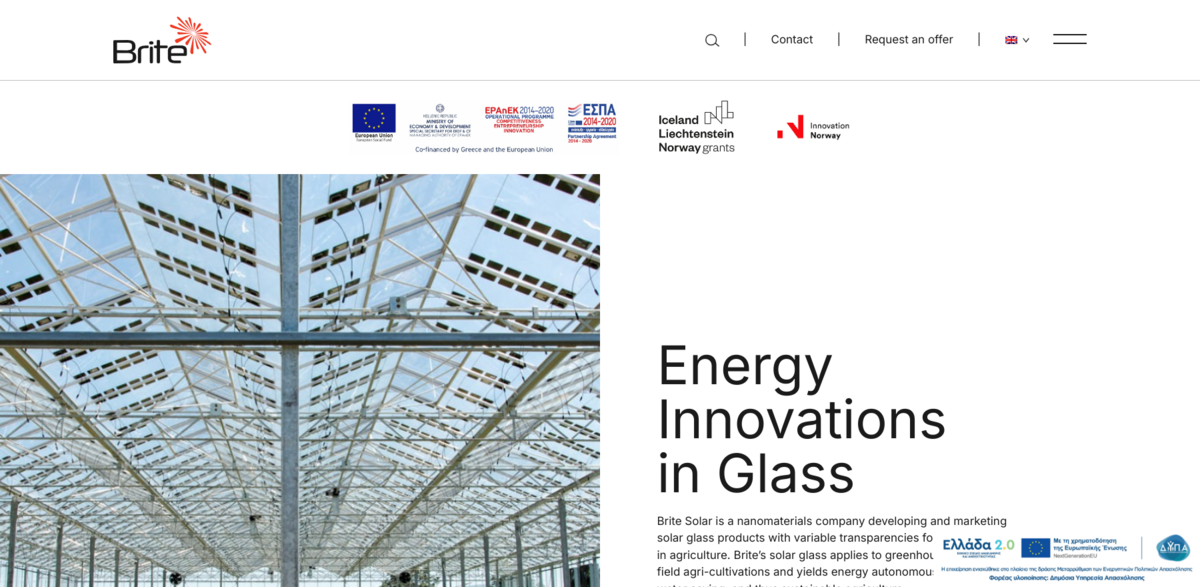What is Brite Solar’s Innovative Project?
Brite Solar is shaking up the world of agriculture and construction with its cutting-edge nanomaterials technology. At its core, the company develops and markets solar glass products with variable transparencies, specially designed for agricultural applications like greenhouses and open-field cultivations. Imagine solar panels that don’t just sit on rooftops but actually blend into the environment—helping farms become energy autonomous while saving water and promoting sustainable agriculture. This isn’t just about energy; it’s about transforming how land is used, making it multifunctional for both food production and renewable energy generation. Pretty cool, right?
Main Benefits of Brite Solar’s Technology
Here’s what makes Brite Solar’s approach stand out:
- Energy autonomous operation for agricultural sites, reducing reliance on external power sources.
- Water savings through optimized greenhouse conditions, supporting sustainable farming practices.
- Dual land use via Agrivoltaics—simultaneous food production and solar energy generation.
- Advanced nanomaterial engineering that creates solar glass with variable transparency.
- Reduction of energy footprint in buildings by integrating dynamic and solar glass technologies.
- Projects implemented in diverse locations, including peach orchards in Greece and apple orchards in Slovenia.
Exploring Brite Solar’s Unique Product Line
Brite Solar’s flagship product is its solar glass, a crucial technology designed to meet the growing demands of sustainable agriculture. With the world’s population on the rise and climate change impacting crop yields, managing the Food/Water/Energy nexus has never been more challenging. Their solar glass allows for the Agrivoltaics concept—using the same land for both food production and renewable energy generation. This means crops grow under semi-transparent solar panels, which create more favorable conditions for plants while producing clean energy. It’s a win-win for farmers and the planet.
Projects Bringing Innovation to Life
Several projects showcase Brite Solar’s technology in action. For example, in Imathia, Greece, semi-transparent solar panels hover above a peach orchard, part of the SOLARHUB initiative that combines energy and crop production. Over in Slovenia, apple orchards benefit from similar Agri-PV installations, while a greenhouse vineyard in Agios Pavlos, Greece, uses semi-transparent panels to achieve energy autonomy and sustainable cultivation. These projects highlight how Brite Solar’s products adapt to different agricultural environments, proving their versatility and impact.
Mission Driving Continuous Innovation
Brite Solar is all about pushing the boundaries of nanomaterial engineering to create glass products that truly make a difference. Their mission focuses on developing high-quality, innovative solutions that not only meet but exceed customer expectations. They’re committed to improving energy efficiency and production worldwide, maintaining open communication with stakeholders, and fostering a culture of continuous improvement. It’s not just about technology; it’s about building a sustainable future through collaboration and dedication.
Impact on Sustainable Development Goals (SDGs)
- SDG 2: Zero Hunger – Enhancing food production through sustainable agricultural practices.
- SDG 6: Clean Water and Sanitation – Promoting water savings in agriculture.
- SDG 7: Affordable and Clean Energy – Generating renewable energy via solar glass technology.
- SDG 9: Industry, Innovation, and Infrastructure – Advancing nanotechnology for energy-efficient building materials.
- SDG 13: Climate Action – Reducing carbon footprint through energy-saving and energy-generating glass products.
- SDG 15: Life on Land – Supporting sustainable land use with Agrivoltaics.
Vision for the Future
Brite Solar envisions a world where advanced nanomaterial engineering revolutionizes agricultural glass products, making it possible to sustainably increase crop yields to feed a growing global population. By integrating energy generation and efficiency into everyday structures, they aim to reduce the energy footprint of buildings and agricultural lands alike. It’s about creating smart, multifunctional materials that serve both people and the planet—because the future of energy and food production depends on innovation that’s as dynamic as the challenges we face.





















